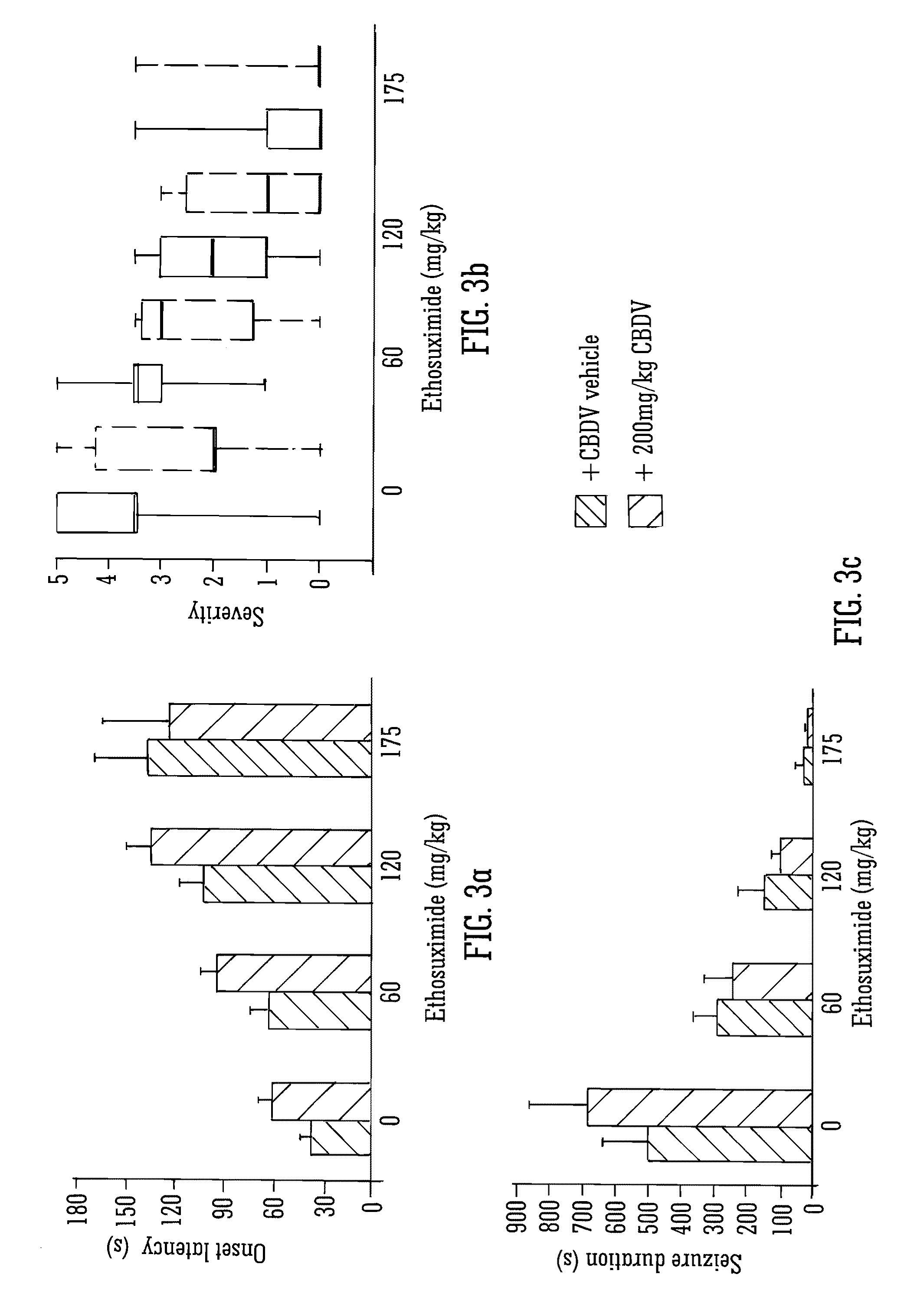Use of the phytocannabinoid cannabidivarin (CBDV) in the treatment of epilepsy
a technology of phytocannabinoid cannabidivarin and cannabinoids, which is applied in the direction of biocide, plant/algae/fungi/lichens, drug compositions, etc., can solve the problems that cannabinoids acting as antagonists of the cb1 receptor may not be useful as anti-cancer agents, and return seizures, etc., to achieve a better side effect profile
- Summary
- Abstract
- Description
- Claims
- Application Information
AI Technical Summary
Benefits of technology
Problems solved by technology
Method used
Image
Examples
example 1
Use of Isolated CBDV in Two In Vitro Epileptiform Models in Hippocampal Brain Slices
[0160]Hippocampal slices were produced acutely from P>21 Wistar rats and activity recorded by multi-electrode arrays (MEA).
[0161]To induce epileptiform activity, either Mg2+ was removed (Mg2+-free model) or 100 μM 4-aminopyridine was added (4-AP model). 30 min after epileptiform burst activity was established, CBDV was added cumulatively (1, 10, 100 μM; 30 min each).
[0162]The effects of CBDV on epileptiform burst amplitude and duration were measured (Table 2.1).
[0163]Overall, CBDV at ≧10 μM or 100 μM significantly decreased burst duration and amplitude in both models with CA1 and DG regions most sensitive and CA3 least sensitive to the anti-epileptiform effects of CBDV.
[0164]
TABLE 2.1Effects of CBDV on epileptiform activity induced in the Mg2+ free and 4-AP modelsCBDVBurst amplitude (% of control)Burst duration (% of control)(μM)DGCA3CA1DGCA3CA1Mg2+o-189.8 ± 8.6112.7 ± 13.782.23 ± 10.490.6 ± 4.5 101...
example 2
Use of Isolated CBDV in the PTZ Model of Generalised Seizures
Methodology:
Animals:
[0165]Male Wistar rats (P24-29; 75-110 g) were used to assess the effects of the phytocannabinoid CBDV in the PTZ model of generalised seizures. Animals were habituated to the test environment, cages, injection protocol and handling prior to experimentation. Animals were housed in a room at 21° C. on a 12 hour light: dark cycle (lights on 0900) in 50% humidity, with free access to food and water.
[0166]The human dose equivalent (HED) can be estimated using the following formula:
[0167]HED=Animaldose(mg / kg)multipliedbyAnimalKmHumanKm
The Km for a rat is 6 and the Km for a human is 37.
Thus, for a human of approx 60 Kg a 200 mg / Kg dose in rat would equate to a human daily dose of about 2000 mg.
Experimental Setup:
[0168]Five 6 L Perspex tanks with lids were placed on a single bench with dividers between them. Closed-circuit television (CCTV) cameras were mounted onto the dividers to observe rat b...
example 3
Use of Isolated CBDV with Standard Anti-Epileptic Drugs (SAEDs) in the PTZ Model of Generalised Seizures
Methodology:
[0190]As described in Example 2 above. Varying doses of the SAED's ethosuximide and valproate were tested in combination to isolated CBDV at a dose of 200 mg / kg.
Results:
[0191]FIGS. 3 and 4 detail the use of the SAED ethosuximide (a drug operating via calcium channels) with isolated CBDV. Although the combination of the two compounds increased the onset latency, reduced seizure duration, resulted in more seizure free animals and reduced tonic / clonic seizures there was no statistically significant interaction between the two compounds. The CBDV gave similar results to valproate for mortality, however significantly CBDV was able to lessen the severity of the epilepsy to a greater degree than the existing epileptic drug valproate.
[0192]FIGS. 5 and 6 detail the use of the SAED valproate (a drug operating via sodium channels) with isolated CBDV. When co-administered, valproa...
PUM
| Property | Measurement | Unit |
|---|---|---|
| humidity | aaaaa | aaaaa |
| Humidity | aaaaa | aaaaa |
| frequency | aaaaa | aaaaa |
Abstract
Description
Claims
Application Information
 Login to View More
Login to View More - R&D
- Intellectual Property
- Life Sciences
- Materials
- Tech Scout
- Unparalleled Data Quality
- Higher Quality Content
- 60% Fewer Hallucinations
Browse by: Latest US Patents, China's latest patents, Technical Efficacy Thesaurus, Application Domain, Technology Topic, Popular Technical Reports.
© 2025 PatSnap. All rights reserved.Legal|Privacy policy|Modern Slavery Act Transparency Statement|Sitemap|About US| Contact US: help@patsnap.com



